HRM Functions, Recruitment Approaches and Workforce Planning: A Report
VerifiedAdded on 2024/05/17
|22
|3882
|112
Report
AI Summary
This report provides a comprehensive analysis of Human Resource Management (HRM) practices within Sainsbury's, focusing on workforce planning, recruitment and selection approaches, and employee relations. It evaluates the purpose and functions of HRM in workforce planning, comparing the strengths and weaknesses of competency and contingency approaches to recruitment. The report assesses how HRM functions contribute to achieving business objectives by providing appropriate talent and skills, and it explores the benefits of various HRM practices for both employers and employees. Furthermore, it evaluates the effectiveness of HRM practices in raising organizational profit and productivity, examines different methods used in HRM, and analyzes the importance of employee relations and employment legislation in HRM decision-making within the organizational context of Sainsbury's.
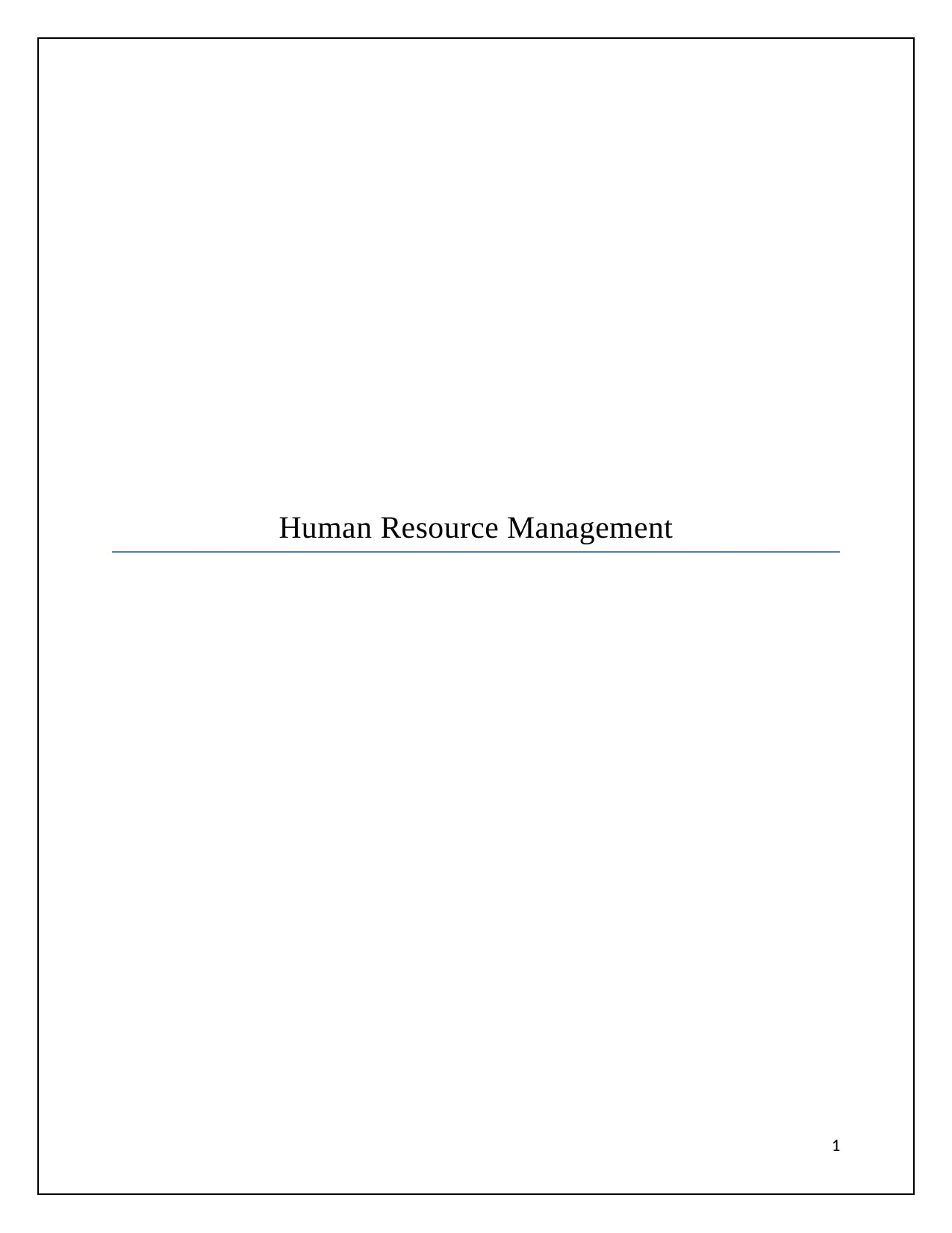
Human Resource Management
1
1
Paraphrase This Document
Need a fresh take? Get an instant paraphrase of this document with our AI Paraphraser
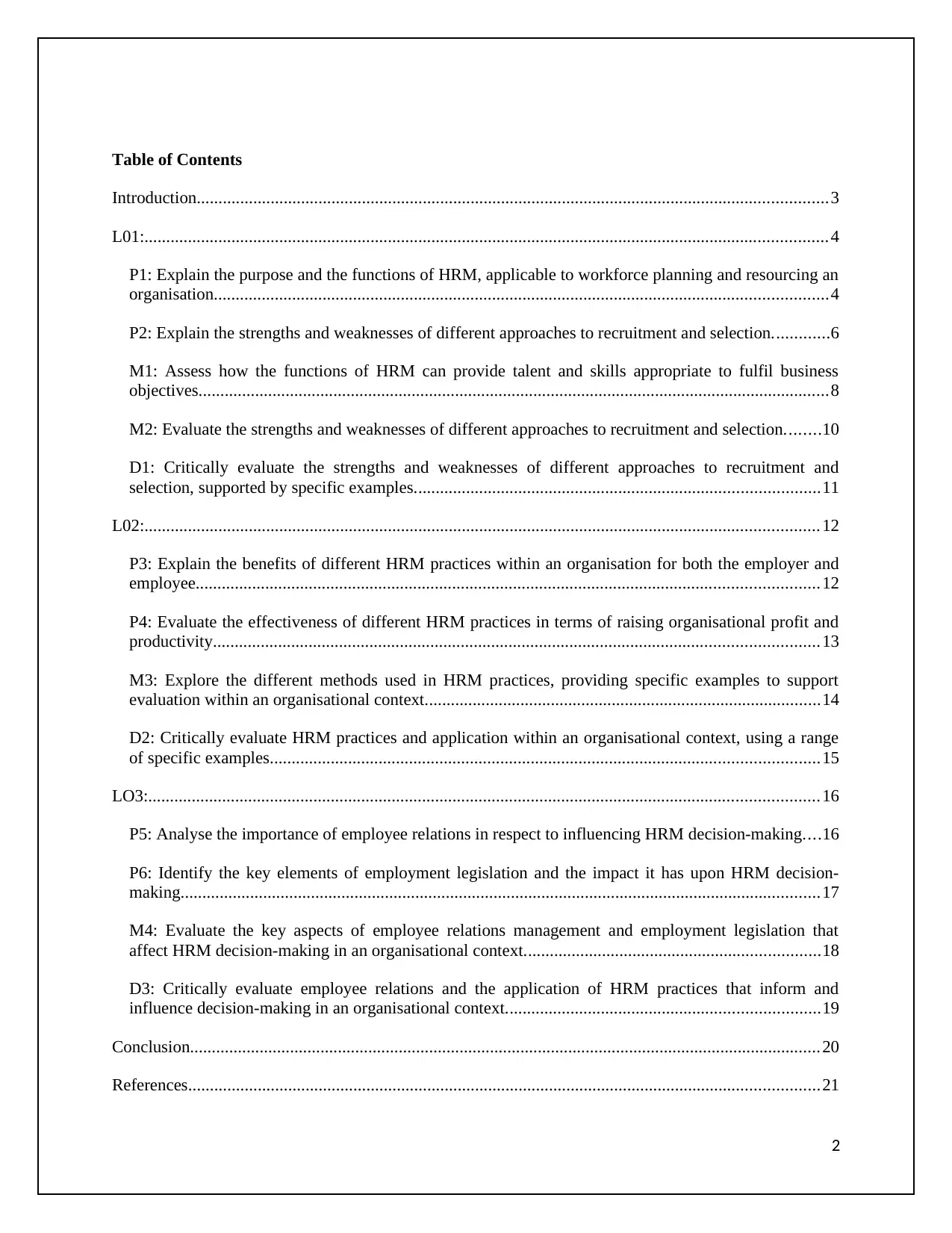
Table of Contents
Introduction.................................................................................................................................................3
L01:.............................................................................................................................................................4
P1: Explain the purpose and the functions of HRM, applicable to workforce planning and resourcing an
organisation.............................................................................................................................................4
P2: Explain the strengths and weaknesses of different approaches to recruitment and selection.............6
M1: Assess how the functions of HRM can provide talent and skills appropriate to fulfil business
objectives.................................................................................................................................................8
M2: Evaluate the strengths and weaknesses of different approaches to recruitment and selection........10
D1: Critically evaluate the strengths and weaknesses of different approaches to recruitment and
selection, supported by specific examples.............................................................................................11
L02:...........................................................................................................................................................12
P3: Explain the benefits of different HRM practices within an organisation for both the employer and
employee...............................................................................................................................................12
P4: Evaluate the effectiveness of different HRM practices in terms of raising organisational profit and
productivity...........................................................................................................................................13
M3: Explore the different methods used in HRM practices, providing specific examples to support
evaluation within an organisational context...........................................................................................14
D2: Critically evaluate HRM practices and application within an organisational context, using a range
of specific examples..............................................................................................................................15
LO3:..........................................................................................................................................................16
P5: Analyse the importance of employee relations in respect to influencing HRM decision-making....16
P6: Identify the key elements of employment legislation and the impact it has upon HRM decision-
making...................................................................................................................................................17
M4: Evaluate the key aspects of employee relations management and employment legislation that
affect HRM decision-making in an organisational context....................................................................18
D3: Critically evaluate employee relations and the application of HRM practices that inform and
influence decision-making in an organisational context........................................................................19
Conclusion.................................................................................................................................................20
References.................................................................................................................................................21
2
Introduction.................................................................................................................................................3
L01:.............................................................................................................................................................4
P1: Explain the purpose and the functions of HRM, applicable to workforce planning and resourcing an
organisation.............................................................................................................................................4
P2: Explain the strengths and weaknesses of different approaches to recruitment and selection.............6
M1: Assess how the functions of HRM can provide talent and skills appropriate to fulfil business
objectives.................................................................................................................................................8
M2: Evaluate the strengths and weaknesses of different approaches to recruitment and selection........10
D1: Critically evaluate the strengths and weaknesses of different approaches to recruitment and
selection, supported by specific examples.............................................................................................11
L02:...........................................................................................................................................................12
P3: Explain the benefits of different HRM practices within an organisation for both the employer and
employee...............................................................................................................................................12
P4: Evaluate the effectiveness of different HRM practices in terms of raising organisational profit and
productivity...........................................................................................................................................13
M3: Explore the different methods used in HRM practices, providing specific examples to support
evaluation within an organisational context...........................................................................................14
D2: Critically evaluate HRM practices and application within an organisational context, using a range
of specific examples..............................................................................................................................15
LO3:..........................................................................................................................................................16
P5: Analyse the importance of employee relations in respect to influencing HRM decision-making....16
P6: Identify the key elements of employment legislation and the impact it has upon HRM decision-
making...................................................................................................................................................17
M4: Evaluate the key aspects of employee relations management and employment legislation that
affect HRM decision-making in an organisational context....................................................................18
D3: Critically evaluate employee relations and the application of HRM practices that inform and
influence decision-making in an organisational context........................................................................19
Conclusion.................................................................................................................................................20
References.................................................................................................................................................21
2

Introduction
In this study, the role of HR in workforce planning in Sainsbury’s has been evaluated along with
the strengths and weaknesses of competency and contingency modes of recruitment and
selection. The various activities performed by the HR which helps to achieve the overall
objectives of Sainsbury’s have also been evaluated. Also, the benefits of the activities performed
by the HR to employees and the management have also been evaluated. The methods used by
Sainsbury’s to evaluate the performance of the employees have also been discussed and the
importance of employee relations and implementing the policies considering the employment
legislation of UK has also been evaluated in the last part of this study.
3
In this study, the role of HR in workforce planning in Sainsbury’s has been evaluated along with
the strengths and weaknesses of competency and contingency modes of recruitment and
selection. The various activities performed by the HR which helps to achieve the overall
objectives of Sainsbury’s have also been evaluated. Also, the benefits of the activities performed
by the HR to employees and the management have also been evaluated. The methods used by
Sainsbury’s to evaluate the performance of the employees have also been discussed and the
importance of employee relations and implementing the policies considering the employment
legislation of UK has also been evaluated in the last part of this study.
3
⊘ This is a preview!⊘
Do you want full access?
Subscribe today to unlock all pages.

Trusted by 1+ million students worldwide
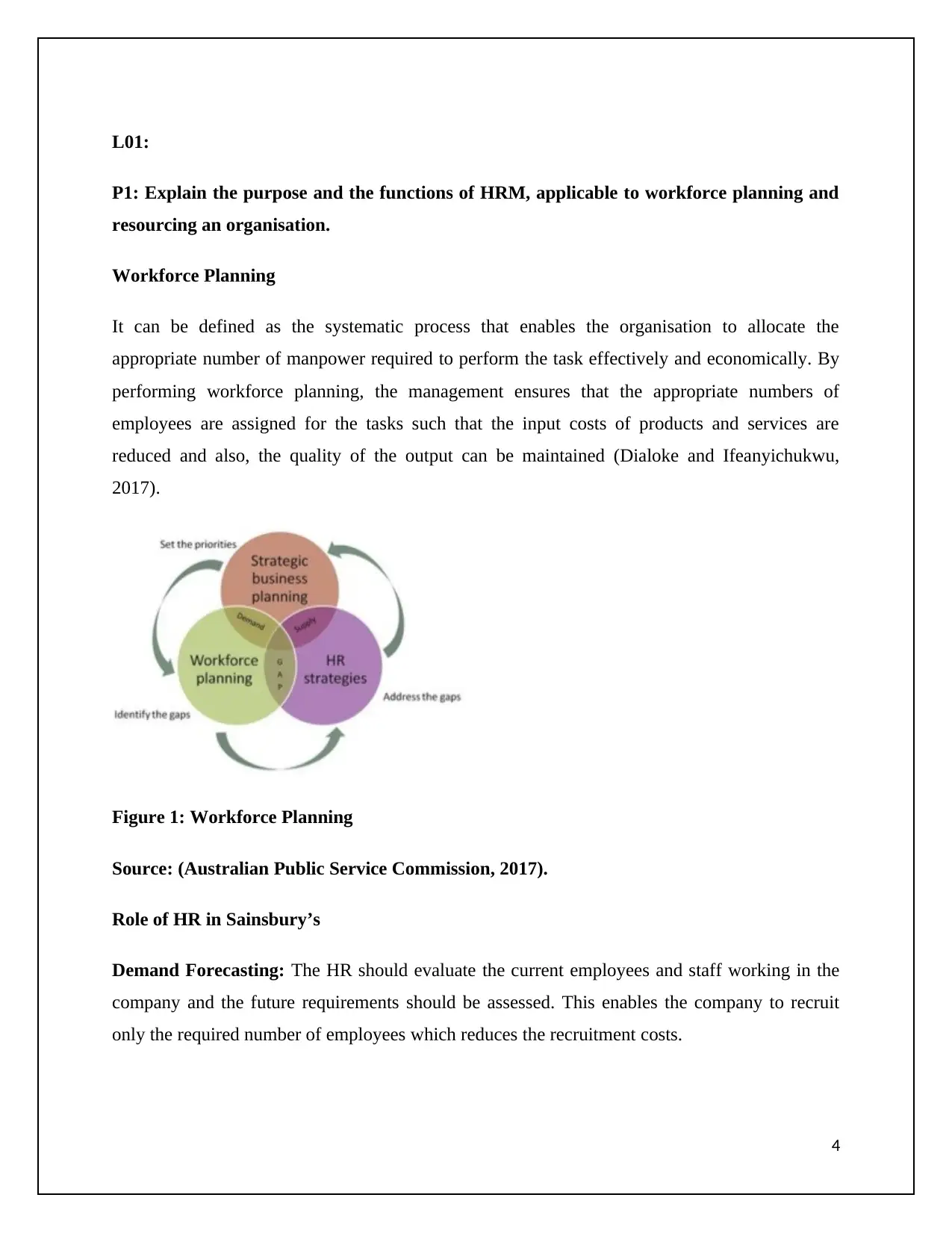
L01:
P1: Explain the purpose and the functions of HRM, applicable to workforce planning and
resourcing an organisation.
Workforce Planning
It can be defined as the systematic process that enables the organisation to allocate the
appropriate number of manpower required to perform the task effectively and economically. By
performing workforce planning, the management ensures that the appropriate numbers of
employees are assigned for the tasks such that the input costs of products and services are
reduced and also, the quality of the output can be maintained (Dialoke and Ifeanyichukwu,
2017).
Figure 1: Workforce Planning
Source: (Australian Public Service Commission, 2017).
Role of HR in Sainsbury’s
Demand Forecasting: The HR should evaluate the current employees and staff working in the
company and the future requirements should be assessed. This enables the company to recruit
only the required number of employees which reduces the recruitment costs.
4
P1: Explain the purpose and the functions of HRM, applicable to workforce planning and
resourcing an organisation.
Workforce Planning
It can be defined as the systematic process that enables the organisation to allocate the
appropriate number of manpower required to perform the task effectively and economically. By
performing workforce planning, the management ensures that the appropriate numbers of
employees are assigned for the tasks such that the input costs of products and services are
reduced and also, the quality of the output can be maintained (Dialoke and Ifeanyichukwu,
2017).
Figure 1: Workforce Planning
Source: (Australian Public Service Commission, 2017).
Role of HR in Sainsbury’s
Demand Forecasting: The HR should evaluate the current employees and staff working in the
company and the future requirements should be assessed. This enables the company to recruit
only the required number of employees which reduces the recruitment costs.
4
Paraphrase This Document
Need a fresh take? Get an instant paraphrase of this document with our AI Paraphraser
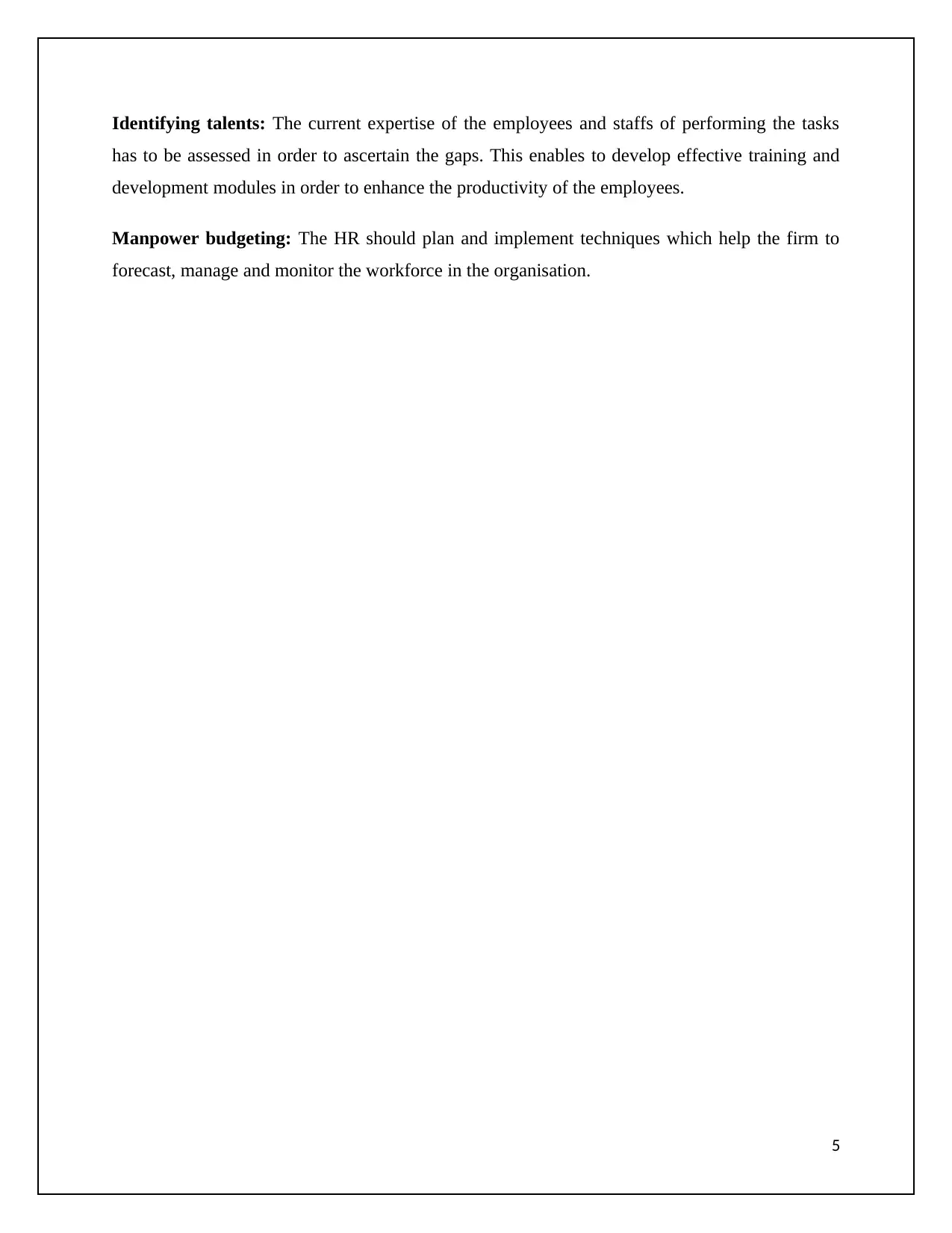
Identifying talents: The current expertise of the employees and staffs of performing the tasks
has to be assessed in order to ascertain the gaps. This enables to develop effective training and
development modules in order to enhance the productivity of the employees.
Manpower budgeting: The HR should plan and implement techniques which help the firm to
forecast, manage and monitor the workforce in the organisation.
5
has to be assessed in order to ascertain the gaps. This enables to develop effective training and
development modules in order to enhance the productivity of the employees.
Manpower budgeting: The HR should plan and implement techniques which help the firm to
forecast, manage and monitor the workforce in the organisation.
5
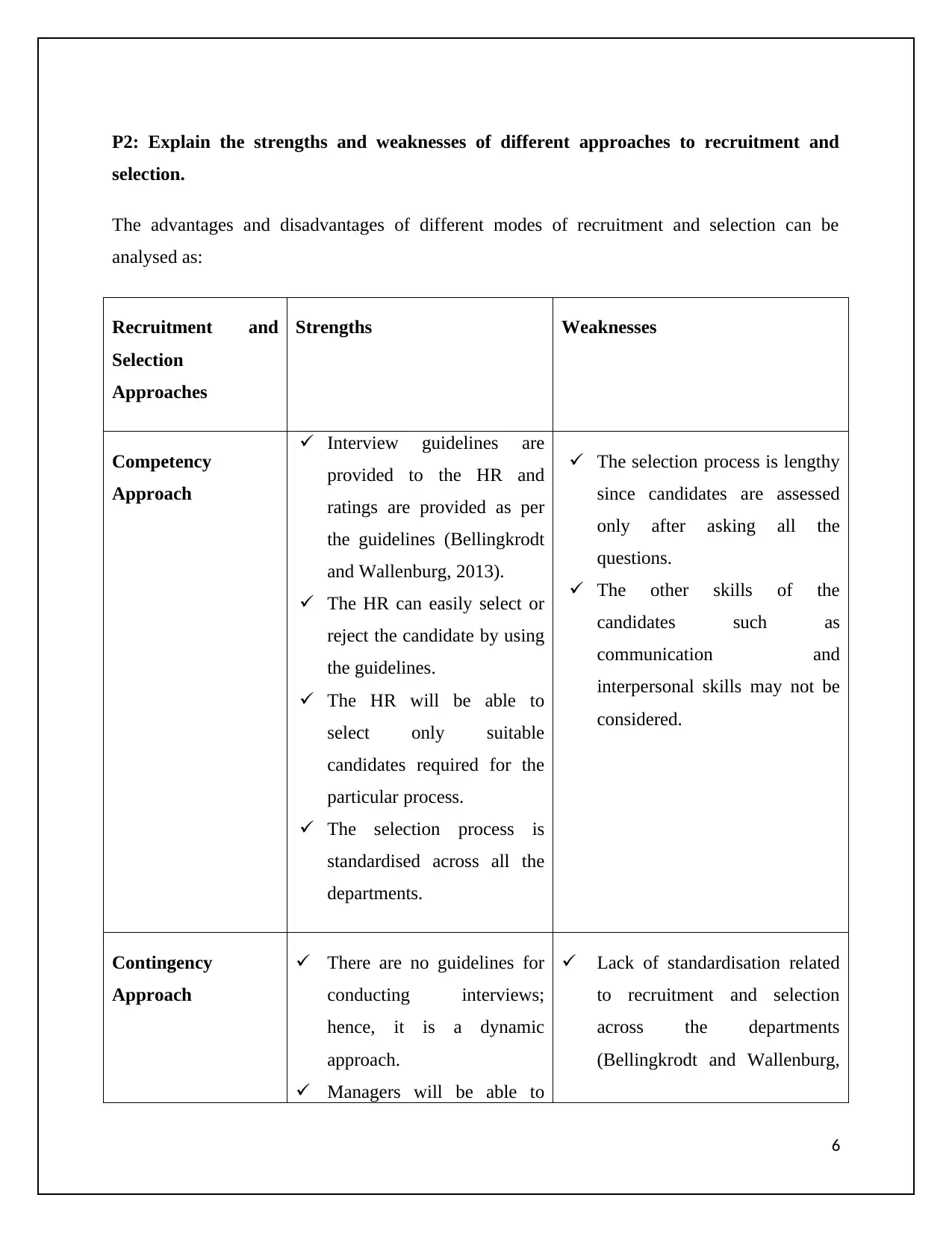
P2: Explain the strengths and weaknesses of different approaches to recruitment and
selection.
The advantages and disadvantages of different modes of recruitment and selection can be
analysed as:
Recruitment and
Selection
Approaches
Strengths Weaknesses
Competency
Approach
Interview guidelines are
provided to the HR and
ratings are provided as per
the guidelines (Bellingkrodt
and Wallenburg, 2013).
The HR can easily select or
reject the candidate by using
the guidelines.
The HR will be able to
select only suitable
candidates required for the
particular process.
The selection process is
standardised across all the
departments.
The selection process is lengthy
since candidates are assessed
only after asking all the
questions.
The other skills of the
candidates such as
communication and
interpersonal skills may not be
considered.
Contingency
Approach
There are no guidelines for
conducting interviews;
hence, it is a dynamic
approach.
Managers will be able to
Lack of standardisation related
to recruitment and selection
across the departments
(Bellingkrodt and Wallenburg,
6
selection.
The advantages and disadvantages of different modes of recruitment and selection can be
analysed as:
Recruitment and
Selection
Approaches
Strengths Weaknesses
Competency
Approach
Interview guidelines are
provided to the HR and
ratings are provided as per
the guidelines (Bellingkrodt
and Wallenburg, 2013).
The HR can easily select or
reject the candidate by using
the guidelines.
The HR will be able to
select only suitable
candidates required for the
particular process.
The selection process is
standardised across all the
departments.
The selection process is lengthy
since candidates are assessed
only after asking all the
questions.
The other skills of the
candidates such as
communication and
interpersonal skills may not be
considered.
Contingency
Approach
There are no guidelines for
conducting interviews;
hence, it is a dynamic
approach.
Managers will be able to
Lack of standardisation related
to recruitment and selection
across the departments
(Bellingkrodt and Wallenburg,
6
⊘ This is a preview!⊘
Do you want full access?
Subscribe today to unlock all pages.

Trusted by 1+ million students worldwide
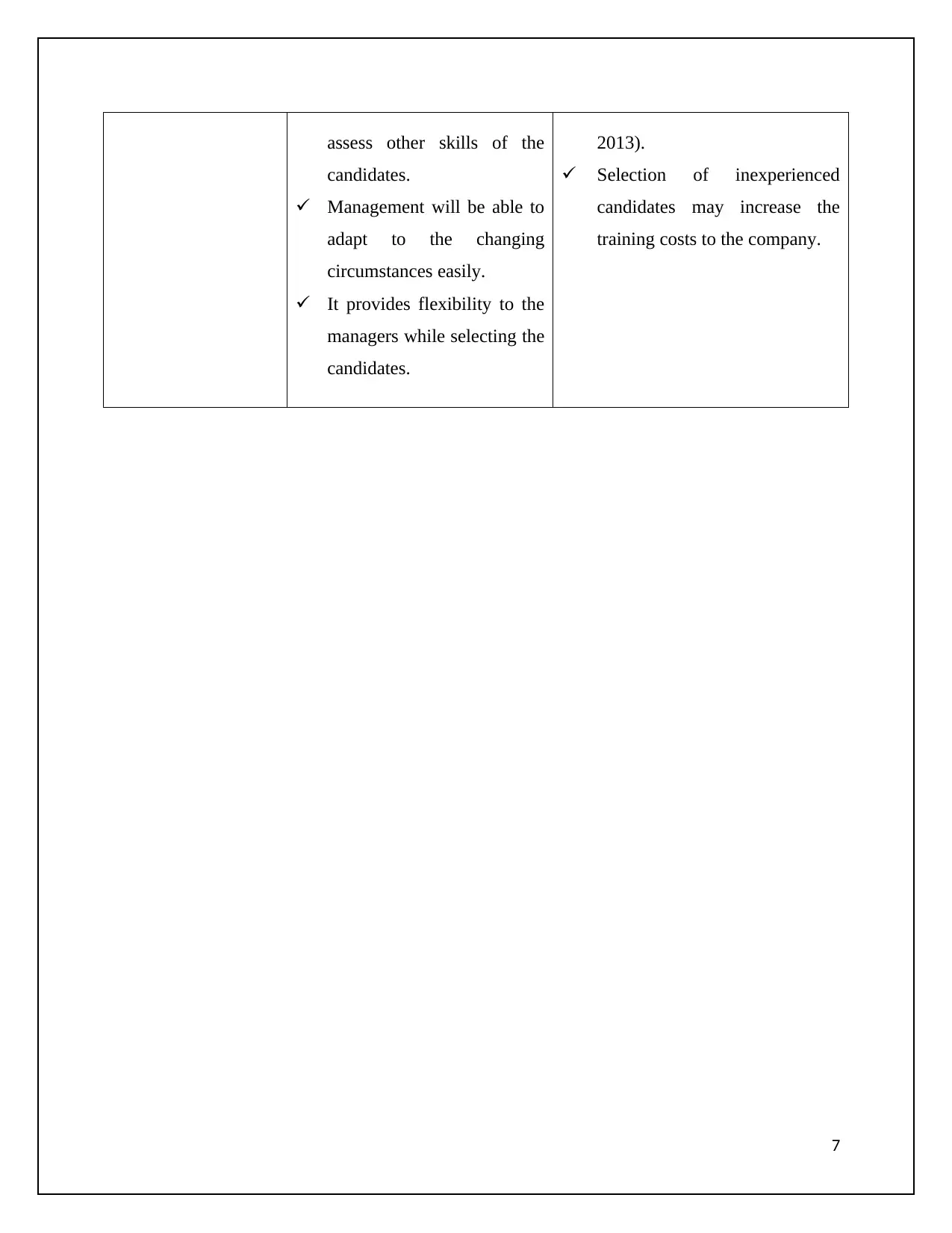
assess other skills of the
candidates.
Management will be able to
adapt to the changing
circumstances easily.
It provides flexibility to the
managers while selecting the
candidates.
2013).
Selection of inexperienced
candidates may increase the
training costs to the company.
7
candidates.
Management will be able to
adapt to the changing
circumstances easily.
It provides flexibility to the
managers while selecting the
candidates.
2013).
Selection of inexperienced
candidates may increase the
training costs to the company.
7
Paraphrase This Document
Need a fresh take? Get an instant paraphrase of this document with our AI Paraphraser
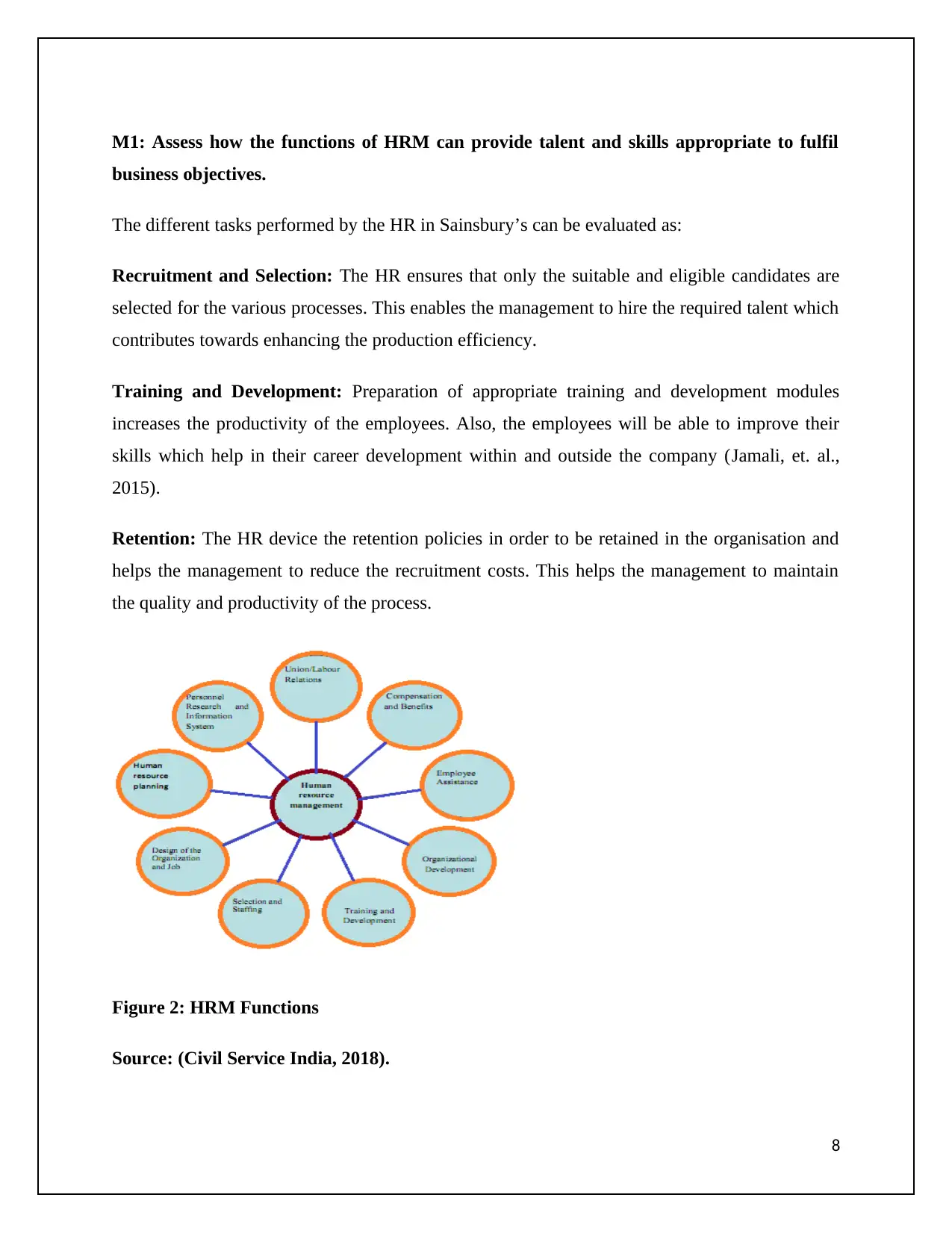
M1: Assess how the functions of HRM can provide talent and skills appropriate to fulfil
business objectives.
The different tasks performed by the HR in Sainsbury’s can be evaluated as:
Recruitment and Selection: The HR ensures that only the suitable and eligible candidates are
selected for the various processes. This enables the management to hire the required talent which
contributes towards enhancing the production efficiency.
Training and Development: Preparation of appropriate training and development modules
increases the productivity of the employees. Also, the employees will be able to improve their
skills which help in their career development within and outside the company (Jamali, et. al.,
2015).
Retention: The HR device the retention policies in order to be retained in the organisation and
helps the management to reduce the recruitment costs. This helps the management to maintain
the quality and productivity of the process.
Figure 2: HRM Functions
Source: (Civil Service India, 2018).
8
business objectives.
The different tasks performed by the HR in Sainsbury’s can be evaluated as:
Recruitment and Selection: The HR ensures that only the suitable and eligible candidates are
selected for the various processes. This enables the management to hire the required talent which
contributes towards enhancing the production efficiency.
Training and Development: Preparation of appropriate training and development modules
increases the productivity of the employees. Also, the employees will be able to improve their
skills which help in their career development within and outside the company (Jamali, et. al.,
2015).
Retention: The HR device the retention policies in order to be retained in the organisation and
helps the management to reduce the recruitment costs. This helps the management to maintain
the quality and productivity of the process.
Figure 2: HRM Functions
Source: (Civil Service India, 2018).
8

Rewards and Recognition: The HR monitors the performance of the employees by taking the
feedback from the managers and suitable rewards are provided for the exceptional work done by
the employees. The HR provides both monetary and non-monetary rewards such as providing
bonus, incentives, promoting the employees, etc.
Payroll Activities: This involves maintaining and updating the records such as attendance
reports, leave reports, monthly working days, etc. This helps the finance department to calculate
the salaries accurately and provide the leave benefits to the employees such as sick leave, paid
leave, etc. (Jamali, et. al., 2015).
9
feedback from the managers and suitable rewards are provided for the exceptional work done by
the employees. The HR provides both monetary and non-monetary rewards such as providing
bonus, incentives, promoting the employees, etc.
Payroll Activities: This involves maintaining and updating the records such as attendance
reports, leave reports, monthly working days, etc. This helps the finance department to calculate
the salaries accurately and provide the leave benefits to the employees such as sick leave, paid
leave, etc. (Jamali, et. al., 2015).
9
⊘ This is a preview!⊘
Do you want full access?
Subscribe today to unlock all pages.

Trusted by 1+ million students worldwide

M2: Evaluate the strengths and weaknesses of different approaches to recruitment and
selection.
Competency approach
Strength:
The selection procedure is designed to ascertain the level of knowledge of the candidates
to perform the tasks related to a job role.
It enables the management to select the experienced candidates or the candidates from
similar fields which reduces the training costs (Bellingkrodt and Wallenburg, 2013).
Weaknesses:
The selection process is time-consuming since each and every question is asked the
candidates to assess their overall knowledge related to the job.
Knowledge about the other process and the task may not be considered while providing
the ratings and hence, the candidates with multi-tasking skills may get rejected.
Contingency Approach
Strength:
This approach provides flexibility to the HR while selecting the candidates and hence,
interview questions are designed to understand the candidates perspective related to the
job.
The HR will be able to adapt to the changing circumstances since there is no rigidity
while selecting the candidates (Bellingkrodt and Wallenburg, 2013).
Weaknesses:
The inexperienced candidates may get selected which increases the training costs.
There will be no uniformity in the company for selecting the candidates within the
company and it may create confusion while designing the person specification for a
particular process.
10
selection.
Competency approach
Strength:
The selection procedure is designed to ascertain the level of knowledge of the candidates
to perform the tasks related to a job role.
It enables the management to select the experienced candidates or the candidates from
similar fields which reduces the training costs (Bellingkrodt and Wallenburg, 2013).
Weaknesses:
The selection process is time-consuming since each and every question is asked the
candidates to assess their overall knowledge related to the job.
Knowledge about the other process and the task may not be considered while providing
the ratings and hence, the candidates with multi-tasking skills may get rejected.
Contingency Approach
Strength:
This approach provides flexibility to the HR while selecting the candidates and hence,
interview questions are designed to understand the candidates perspective related to the
job.
The HR will be able to adapt to the changing circumstances since there is no rigidity
while selecting the candidates (Bellingkrodt and Wallenburg, 2013).
Weaknesses:
The inexperienced candidates may get selected which increases the training costs.
There will be no uniformity in the company for selecting the candidates within the
company and it may create confusion while designing the person specification for a
particular process.
10
Paraphrase This Document
Need a fresh take? Get an instant paraphrase of this document with our AI Paraphraser

D1: Critically evaluate the strengths and weaknesses of different approaches to
recruitment and selection, supported by specific examples.
The strengths of competency approach can be evaluated as this approach helps the management
to hire talented and experienced candidates since the selection criteria is pre-defined. The
interview process enables the HR to accurately ascertain the knowledge and expertise of the
candidates. The weakness of this approach is that the other skills such as interpersonal skills may
not be considered while rating the candidates’ performance in the interview, which may result in
rejecting the talented candidates (Bellingkrodt and Wallenburg, 2013).
The strength of contingency approach is that it provides the flexibility to the HR while selecting
the candidates and hence, the HR will be able to adapt the interview process as per the changing
circumstances. The weakness of this approach is that since there are no pre-defined criteria of
selection, the HR may select unsuitable candidates which may result in increasing the training
costs.
11
recruitment and selection, supported by specific examples.
The strengths of competency approach can be evaluated as this approach helps the management
to hire talented and experienced candidates since the selection criteria is pre-defined. The
interview process enables the HR to accurately ascertain the knowledge and expertise of the
candidates. The weakness of this approach is that the other skills such as interpersonal skills may
not be considered while rating the candidates’ performance in the interview, which may result in
rejecting the talented candidates (Bellingkrodt and Wallenburg, 2013).
The strength of contingency approach is that it provides the flexibility to the HR while selecting
the candidates and hence, the HR will be able to adapt the interview process as per the changing
circumstances. The weakness of this approach is that since there are no pre-defined criteria of
selection, the HR may select unsuitable candidates which may result in increasing the training
costs.
11

L02:
P3: Explain the benefits of different HRM practices within an organisation for both the
employer and employee.
The HR performs various tasks in Sainsbury’s which benefits both the employees and the
company and these functions can be evaluated as:
HR Functions Benefits to Management Benefit to Employees
Recruitment and
Selection
The selection process is
developed to ascertain the actual
knowledge of the candidates.
Selection of appropriate
candidates reduces training costs
(Long, et. al., 2012).
There is no bias in the
selection and candidates are
provided opportunities to work and
grow in the company.
Training and
Development
Enhances the productivity of
the employees.
Minimises wastages and
reduced input costs.
Employees understand the
job requirements and perform the
tasks accordingly.
Performance
Management
The management will be able
to identify the available talents.
Effectively manage the
employees by the way of promotions
and transfers.
Ensures employees career
development within and outside the
company.
Rewards and
Recognition
Enables the management to
motivate the employees to improve
Employees will be able to
improve their career and financial
12
P3: Explain the benefits of different HRM practices within an organisation for both the
employer and employee.
The HR performs various tasks in Sainsbury’s which benefits both the employees and the
company and these functions can be evaluated as:
HR Functions Benefits to Management Benefit to Employees
Recruitment and
Selection
The selection process is
developed to ascertain the actual
knowledge of the candidates.
Selection of appropriate
candidates reduces training costs
(Long, et. al., 2012).
There is no bias in the
selection and candidates are
provided opportunities to work and
grow in the company.
Training and
Development
Enhances the productivity of
the employees.
Minimises wastages and
reduced input costs.
Employees understand the
job requirements and perform the
tasks accordingly.
Performance
Management
The management will be able
to identify the available talents.
Effectively manage the
employees by the way of promotions
and transfers.
Ensures employees career
development within and outside the
company.
Rewards and
Recognition
Enables the management to
motivate the employees to improve
Employees will be able to
improve their career and financial
12
⊘ This is a preview!⊘
Do you want full access?
Subscribe today to unlock all pages.

Trusted by 1+ million students worldwide
1 out of 22
Related Documents
Your All-in-One AI-Powered Toolkit for Academic Success.
+13062052269
info@desklib.com
Available 24*7 on WhatsApp / Email
![[object Object]](/_next/static/media/star-bottom.7253800d.svg)
Unlock your academic potential
Copyright © 2020–2025 A2Z Services. All Rights Reserved. Developed and managed by ZUCOL.




